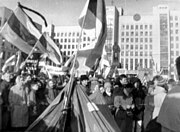Belarusian nationalism: Difference between revisions
adding NPOV as this article is clearly biased re: specific figures and provides a one-sided view of Belarusian nationalism without reference to current events |
m adding Belarus category |
||
| Line 40: | Line 40: | ||
[[Category:Belarusian nationalism| ]] |
[[Category:Belarusian nationalism| ]] |
||
[[Category:Belarus]] |
|||
Revision as of 20:53, 23 September 2020

Belarusian nationalism is the Belarusian form of nationalism. The Belarusian People's Republic was established in 1918 and ceased to exist in 1919 with its territories captured by Polish and Bolshevik forces in the Polish-Soviet War, and near the end of the 20th century, the independent Republic of Belarus was proclaimed.[1][2] Today there is a number of organisations with the ideological basis of Belarusian nationalism, including the BPF Party, the CCP BPF, Young Front and the Right Alliance, however since the 2000s, Belarusian nationalism, where nationalists opposed the government of Alexander Lukashenko, has declined with few nationalist organisations currently existing. Lukashenko during his time as president has been described as anti-nationalist. The once prominent nationalist politician, Zianon Paźniak, has been described as authoritarian and radical with his politics blamed as one of the reasons for the defeat of the opposition in the 1990s.[3]

Following the Russian military intervention in Ukraine in 2014, a number of Belarusian nationalists fought with Ukrainian government troops.[4][5][6] The Monument to the Belarusians who died for Ukraine was opened on March 28, 2016 in Kiev, the capital of Ukraine.[7]
Gallery
-
Belarusian national white-red-white flag on a house of National Secretariat of Belarusian People's Republic, (Minsk, 1918)
-
Third charter of Belarusian People's Republic (Minsk, 1918)
-
Government of Belarusian People's Republic (Minsk, 1918)
-
Belarusian housars in front of the house of Tribunal in Hrodna (1919)
-
Anti-communist rally organized by Belarusian Popular Front (Minsk, 1990)
-
Anti-communist rally organized by Belarusian Popular Front (Minsk, 1990)
-
Opposition Protests (Minsk, 2006)
-
Celebrating the 100th anniversary of the Belarusian People's Republic (Minsk, 2018)
Literature
- Krushinsky S. Byelorussian Communism and Nationalism: Personal Recollections. New York, 1953.
- Vakar N. P. Belorussia. The Making of Nation. Cambridge, Massachusetts, 1956.
- Bulhakau V. The History of Belarusan Nationalism. Vilnya, 2007. [Валер Булгакаў. Гісторыя беларускага нацыяналізму. — Вільня: Інстытут беларусістыкі, 2007. — 331 с. (in Belarusian)]
- Marples D. R. Belarus: A Denationalized Nation. Abingdon, Routledge, 2013.
- Rudling P. A. The Rise and Fall of Belarusian Nationalism, 1906–1931. University of Pittsburgh Press, 2014.
- Hroch M. European Nations: Explaining their Formation. London, 2015.
- Fabrykant M. Russian-speaking Belarusian Nationalism: An Ethnolinguistic Identity Without a Language?, Europe-Asia Studies, 2019.
See also
References
- ^ Zianon Pazniak. Belarus is an Eastern Outspot
- ^ Vadzim Smok. Belarusian Identity: the Impact of Lukashenka’s Rule // Analytical Paper. Ostrogorski Centre, BelarusDigest, 9 December 2013
- ^ Is There Nationalism in Belarus? // BelarusDigest, 5 March 2013
- ^ Belarusian ‘Vayar’ vs. ‘Black Hundred’ // InformNapalm
- ^ Belarusians are fighting in Avdeevka? // WeapoNews.com
- ^ Belarus Slowly and Carefully Walks Along the Ukrainian Path // stalkerzone.org
- ^ Monument to Belarusians who died for Ukraine was opened in Kyiv // Belsat TV








